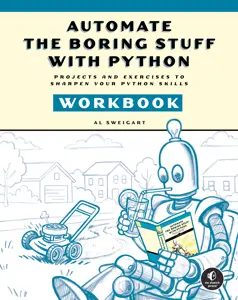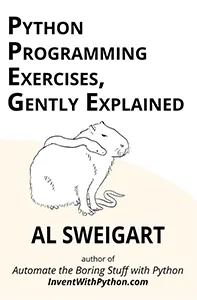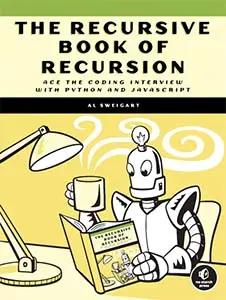








Blackjack, also known as 21, is a card game where players try to get as close to 21 points as possible without going over. This program uses images drawn with text characters, called ASCII art. American Standard Code for Information Interchange (ASCII) is a mapping of text characters to numeric codes that computers used before Unicode replaced it. The playing cards in this program are an example of ASCII art:
___ ___
|A | |10 |
| ♣ | | ♦ |
|__A| |_10|You can find other rules and the history of this card game at https://en.wikipedia.org/wiki/Blackjack.
When you run blackjack.py, the output will look like this:
Blackjack, by Al Sweigart [email protected]
Rules:
Try to get as close to 21 without going over.
Kings, Queens, and Jacks are worth 10 points.
Aces are worth 1 or 11 points.
Cards 2 through 10 are worth their face value.
(H)it to take another card.
(S)tand to stop taking cards.
On your first play, you can (D)ouble down to increase your bet
but must hit exactly one more time before standing.
In case of a tie, the bet is returned to the player.
The dealer stops hitting at 17.
Money: 5000
How much do you bet? (1-5000, or QUIT)
> 400
Bet: 400
DEALER: ???
___ ___
|## | |2 |
|###| | ♥ |
|_##| |__2|
PLAYER: 17
___ ___
|K | |7 |
| ♠ | | ♦ |
|__K| |__7|
(H)it, (S)tand, (D)ouble down
> h
You drew a 4 of ♦.
--snip--
DEALER: 18
___ ___ ___
|K | |2 | |6 |
| ♦ | | ♥ | | ♠ |
|__K| |__2| |__6|
PLAYER: 21
___ ___ ___
|K | |7 | |4 |
| ♠ | | ♦ | | ♦ |
|__K| |__7| |__4|
You won $400!
--snip—The card suit symbols don’t exist on your keyboard, which is why we call the chr() function to create them. The integer passed to chr() is called a Unicode code point, a unique number that identifies a character according to the Unicode standard. Unicode is often misunderstood. However, Ned Batchelder’s 2012 PyCon US talk “Pragmatic Unicode, or How Do I Stop the Pain?” is an excellent introduction to Unicode, and you can find it at https://youtu.be/sgHbC6udIqc/. Appendix B gives a full list of Unicode characters you can use in your Python programs.
1. """Blackjack, by Al Sweigart [email protected]
2. The classic card game also known as 21. (This version doesn't have
3. splitting or insurance.)
4. More info at: https://en.wikipedia.org/wiki/Blackjack
5. View this code at https://nostarch.com/big-book-small-python-projects
6. Tags: large, game, card game"""
7.
8. import random, sys
9.
10. # Set up the constants:
11. HEARTS = chr(9829) # Character 9829 is '♥'.
12. DIAMONDS = chr(9830) # Character 9830 is '♦'.
13. SPADES = chr(9824) # Character 9824 is '♠'.
14. CLUBS = chr(9827) # Character 9827 is '♣'.
15. # (A list of chr codes is at https://inventwithpython.com/charactermap)
16. BACKSIDE = 'backside'
17.
18.
19. def main():
20. print('''Blackjack, by Al Sweigart [email protected]
21.
22. Rules:
23. Try to get as close to 21 without going over.
24. Kings, Queens, and Jacks are worth 10 points.
25. Aces are worth 1 or 11 points.
26. Cards 2 through 10 are worth their face value.
27. (H)it to take another card.
28. (S)tand to stop taking cards.
29. On your first play, you can (D)ouble down to increase your bet
30. but must hit exactly one more time before standing.
31. In case of a tie, the bet is returned to the player.
32. The dealer stops hitting at 17.''')
33.
34. money = 5000
35. while True: # Main game loop.
36. # Check if the player has run out of money:
37. if money <= 0:
38. print("You're broke!")
39. print("Good thing you weren't playing with real money.")
40. print('Thanks for playing!')
41. sys.exit()
42.
43. # Let the player enter their bet for this round:
44. print('Money:', money)
45. bet = getBet(money)
46.
47. # Give the dealer and player two cards from the deck each:
48. deck = getDeck()
49. dealerHand = [deck.pop(), deck.pop()]
50. playerHand = [deck.pop(), deck.pop()]
51.
52. # Handle player actions:
53. print('Bet:', bet)
54. while True: # Keep looping until player stands or busts.
55. displayHands(playerHand, dealerHand, False)
56. print()
57.
58. # Check if the player has bust:
59. if getHandValue(playerHand) > 21:
60. break
61.
62. # Get the player's move, either H, S, or D:
63. move = getMove(playerHand, money - bet)
64.
65. # Handle the player actions:
66. if move == 'D':
67. # Player is doubling down, they can increase their bet:
68. additionalBet = getBet(min(bet, (money - bet)))
69. bet += additionalBet
70. print('Bet increased to {}.'.format(bet))
71. print('Bet:', bet)
72.
73. if move in ('H', 'D'):
74. # Hit/doubling down takes another card.
75. newCard = deck.pop()
76. rank, suit = newCard
77. print('You drew a {} of {}.'.format(rank, suit))
78. playerHand.append(newCard)
79.
80. if getHandValue(playerHand) > 21:
81. # The player has busted:
82. continue
83.
84. if move in ('S', 'D'):
85. # Stand/doubling down stops the player's turn.
86. break
87.
88. # Handle the dealer's actions:
89. if getHandValue(playerHand) <= 21:
90. while getHandValue(dealerHand) < 17:
91. # The dealer hits:
92. print('Dealer hits...')
93. dealerHand.append(deck.pop())
94. displayHands(playerHand, dealerHand, False)
95.
96. if getHandValue(dealerHand) > 21:
97. break # The dealer has busted.
98. input('Press Enter to continue...')
99. print('\n\n')
100.
101. # Show the final hands:
102. displayHands(playerHand, dealerHand, True)
103.
104. playerValue = getHandValue(playerHand)
105. dealerValue = getHandValue(dealerHand)
106. # Handle whether the player won, lost, or tied:
107. if dealerValue > 21:
108. print('Dealer busts! You win ${}!'.format(bet))
109. money += bet
110. elif (playerValue > 21) or (playerValue < dealerValue):
111. print('You lost!')
112. money -= bet
113. elif playerValue > dealerValue:
114. print('You won ${}!'.format(bet))
115. money += bet
116. elif playerValue == dealerValue:
117. print('It\'s a tie, the bet is returned to you.')
118.
119. input('Press Enter to continue...')
120. print('\n\n')
121.
122.
123. def getBet(maxBet):
124. """Ask the player how much they want to bet for this round."""
125. while True: # Keep asking until they enter a valid amount.
126. print('How much do you bet? (1-{}, or QUIT)'.format(maxBet))
127. bet = input('> ').upper().strip()
128. if bet == 'QUIT':
129. print('Thanks for playing!')
130. sys.exit()
131.
132. if not bet.isdecimal():
133. continue # If the player didn't enter a number, ask again.
134.
135. bet = int(bet)
136. if 1 <= bet <= maxBet:
137. return bet # Player entered a valid bet.
138.
139.
140. def getDeck():
141. """Return a list of (rank, suit) tuples for all 52 cards."""
142. deck = []
143. for suit in (HEARTS, DIAMONDS, SPADES, CLUBS):
144. for rank in range(2, 11):
145. deck.append((str(rank), suit)) # Add the numbered cards.
146. for rank in ('J', 'Q', 'K', 'A'):
147. deck.append((rank, suit)) # Add the face and ace cards.
148. random.shuffle(deck)
149. return deck
150.
151.
152. def displayHands(playerHand, dealerHand, showDealerHand):
153. """Show the player's and dealer's cards. Hide the dealer's first
154. card if showDealerHand is False."""
155. print()
156. if showDealerHand:
157. print('DEALER:', getHandValue(dealerHand))
158. displayCards(dealerHand)
159. else:
160. print('DEALER: ???')
161. # Hide the dealer's first card:
162. displayCards([BACKSIDE] + dealerHand[1:])
163.
164. # Show the player's cards:
165. print('PLAYER:', getHandValue(playerHand))
166. displayCards(playerHand)
167.
168.
169. def getHandValue(cards):
170. """Returns the value of the cards. Face cards are worth 10, aces are
171. worth 11 or 1 (this function picks the most suitable ace value)."""
172. value = 0
173. numberOfAces = 0
174.
175. # Add the value for the non-ace cards:
176. for card in cards:
177. rank = card[0] # card is a tuple like (rank, suit)
178. if rank == 'A':
179. numberOfAces += 1
180. elif rank in ('K', 'Q', 'J'): # Face cards are worth 10 points.
181. value += 10
182. else:
183. value += int(rank) # Numbered cards are worth their number.
184.
185. # Add the value for the aces:
186. value += numberOfAces # Add 1 per ace.
187. for i in range(numberOfAces):
188. # If another 10 can be added with busting, do so:
189. if value + 10 <= 21:
190. value += 10
191.
192. return value
193.
194.
195. def displayCards(cards):
196. """Display all the cards in the cards list."""
197. rows = ['', '', '', '', ''] # The text to display on each row.
198.
199. for i, card in enumerate(cards):
200. rows[0] += ' ___ ' # Print the top line of the card.
201. if card == BACKSIDE:
202. # Print a card's back:
203. rows[1] += '|## | '
204. rows[2] += '|###| '
205. rows[3] += '|_##| '
206. else:
207. # Print the card's front:
208. rank, suit = card # The card is a tuple data structure.
209. rows[1] += '|{} | '.format(rank.ljust(2))
210. rows[2] += '| {} | '.format(suit)
211. rows[3] += '|_{}| '.format(rank.rjust(2, '_'))
212.
213. # Print each row on the screen:
214. for row in rows:
215. print(row)
216.
217.
218. def getMove(playerHand, money):
219. """Asks the player for their move, and returns 'H' for hit, 'S' for
220. stand, and 'D' for double down."""
221. while True: # Keep looping until the player enters a correct move.
222. # Determine what moves the player can make:
223. moves = ['(H)it', '(S)tand']
224.
225. # The player can double down on their first move, which we can
226. # tell because they'll have exactly two cards:
227. if len(playerHand) == 2 and money > 0:
228. moves.append('(D)ouble down')
229.
230. # Get the player's move:
231. movePrompt = ', '.join(moves) + '> '
232. move = input(movePrompt).upper()
233. if move in ('H', 'S'):
234. return move # Player has entered a valid move.
235. if move == 'D' and '(D)ouble down' in moves:
236. return move # Player has entered a valid move.
237.
238.
239. # If the program is run (instead of imported), run the game:
240. if __name__ == '__main__':
241. main()After entering the source code and running it a few times, try making experimental changes to it. Blackjack has several custom rules that you could implement. For example, if the first two cards have the same value, a player can split them into two hands and wager on them separately. Also, if the player receives a “blackjack” (the ace of spades and a black jack) for their first two cards, the player wins a ten-to-one payout. You can find out more about the game from https://en.wikipedia.org/wiki/Blackjack.
Try to find the answers to the following questions. Experiment with some modifications to the code and rerun the program to see what effect the changes have.
rows list (created on line 197) represent?random.shuffle(deck) on line 148?money -= bet on line 112 to money += bet?showDealerHand in the displayHands() function is set to True? What happens when it is False?